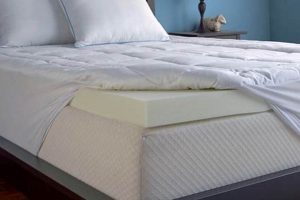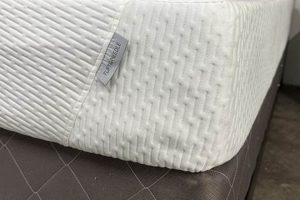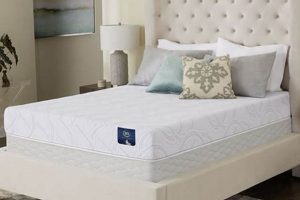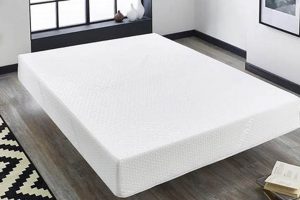A specific type of bedding product, this refers to a mattress composed of memory foam with a depth of approximately six inches, sized to fit a twin bed frame. These mattresses are often chosen for their conforming support and suitability for individual sleepers.
The significance of this mattress class lies in its balance between affordability, comfort, and space efficiency. The memory foam layer provides pressure relief, potentially improving sleep quality. The twin size makes it ideal for smaller spaces, guest rooms, or children’s bedrooms. Historically, this mattress type represents an evolution in bedding technology, offering an alternative to traditional innerspring mattresses.
Considering the features and benefits, this article will further delve into the specifications, advantages, and potential drawbacks of mattresses within this category. It will also explore factors to consider when making a purchase decision, ensuring an informed choice based on individual needs and preferences.
Tips for Selecting a 6-Inch Memory Foam Twin Mattress
Proper selection ensures optimal comfort and support. The following guidelines facilitate an informed purchase decision.
Tip 1: Assess Support Needs: Consider the sleeper’s weight and sleeping position. Lighter individuals or back sleepers may find the 6-inch profile adequate, while heavier individuals or side sleepers might require a thicker mattress for sufficient pressure relief and spinal alignment.
Tip 2: Evaluate Foam Density: Higher density memory foam typically offers greater durability and support. Examine the product specifications to determine the foam’s density, usually measured in pounds per cubic foot. A higher density suggests a longer lifespan.
Tip 3: Consider Temperature Regulation: Memory foam can retain heat. Look for mattresses with cooling technologies, such as gel-infused foam or breathable covers, especially if prone to overheating during sleep. These features can promote a more comfortable sleep environment.
Tip 4: Check for Certifications: Certifications like CertiPUR-US ensure that the foam has been tested for harmful substances, VOC emissions, and durability. These certifications provide assurance regarding the mattress’s safety and environmental impact.
Tip 5: Review the Warranty: A comprehensive warranty indicates the manufacturer’s confidence in the product’s quality. Pay attention to the warranty’s terms and conditions, including the duration of coverage and what is covered.
Tip 6: Read Customer Reviews: Gather insights from other purchasers. Customer reviews provide valuable information about the mattress’s real-world performance, including comfort, support, and durability over time.
Tip 7: Consider Edge Support: Evaluate edge support, especially if routinely sitting on the edge of the bed. Stronger edge support prevents sagging and maximizes the usable sleeping surface.
Adhering to these recommendations will increase the likelihood of selecting a suitable sleeping surface. The correct selection ensures a balance of comfort, support, and durability.
These tips offer a foundation for making an informed decision. The next section discusses potential drawbacks and alternative mattress options.
1. Firmness
Firmness is a critical attribute of any mattress, directly impacting the user’s comfort and spinal alignment. When considering a six-inch memory foam twin mattress, understanding firmness levels and their suitability for individual needs is paramount.
- Firmness Scale and Perception
Mattress firmness is typically categorized on a scale ranging from very soft to very firm. This perception is subjective, varying based on individual weight, sleeping position, and personal preference. A six-inch memory foam mattress may feel firmer to a heavier individual compared to a lighter person. For instance, a mattress rated as “medium-firm” might provide adequate support for a back sleeper but prove too rigid for a side sleeper seeking pressure relief at the shoulders and hips.
- Impact on Spinal Alignment
Proper spinal alignment is essential for preventing back pain and promoting restful sleep. The firmness level of the memory foam twin mattress must adequately support the natural curvature of the spine. A mattress that is too soft may cause the spine to sink, while one that is too firm may create pressure points. Individuals should assess their spinal alignment in their preferred sleeping position to determine the appropriate firmness level. A six-inch profile may be inherently firmer than thicker counterparts, necessitating careful evaluation.
- Relationship with Memory Foam Density
While firmness refers to the overall feel of the mattress, memory foam density influences its support and durability. Higher-density memory foam tends to provide greater support and resistance to compression, potentially contributing to a firmer feel. Conversely, lower-density foam may feel softer but may also be less durable and offer less support. In a six-inch mattress, the density of the foam becomes even more crucial as it directly affects the mattress’s ability to provide adequate support without being excessively firm.
- Firmness Preferences Based on Sleeping Position
Sleeping position significantly influences the ideal firmness level. Side sleepers typically benefit from a softer to medium-firm mattress that allows the shoulders and hips to sink in, relieving pressure points. Back sleepers often prefer a medium-firm mattress that provides spinal support without excessive sinking. Stomach sleepers generally require a firmer mattress to prevent excessive arching of the back. Considering these positional preferences is critical when choosing a six-inch memory foam twin mattress, as its limited thickness may restrict the range of available firmness options.
The appropriate firmness of a six-inch memory foam twin mattress is a function of individual body type, sleeping posture, and preferences, all of which must align for a satisfactory sleep experience. Because of it’s small size, this mattress can have varying levels of firmness.
2. Support
Support is a fundamental characteristic of a mattress, determining its capacity to maintain spinal alignment and distribute body weight evenly. For a six-inch memory foam twin mattress, the level of support provided is particularly crucial due to its limited thickness. The foam’s density and construction directly influence its ability to offer adequate support for various body types and sleeping positions.
- Core Density and Load-Bearing Capacity
The density of the memory foam core significantly affects the mattress’s load-bearing capacity. Higher-density foam offers greater resistance to compression, preventing excessiv
e sinking and promoting proper spinal alignment. This is especially important for individuals with higher body weights, as a low-density foam core may not provide sufficient support, leading to discomfort and potential back pain. A six-inch mattress, by virtue of its limited depth, relies heavily on core density to deliver adequate support. - Conforming Properties and Pressure Relief
Memory foam’s ability to conform to the body’s contours is a key aspect of its support system. This conforming action helps distribute weight evenly, reducing pressure points that can cause discomfort and disrupt sleep. A six-inch memory foam twin mattress must strike a balance between conforming comfort and underlying support to prevent sinking too deeply and compromising spinal alignment. The quality and type of memory foam used play a crucial role in achieving this balance.
- Edge Support and Sleep Surface Utilization
Edge support refers to the mattress’s ability to maintain its shape and firmness along its perimeter. Stronger edge support allows sleepers to utilize the entire surface of the mattress without feeling like they are going to roll off. It also facilitates sitting on the edge of the bed without excessive compression. A six-inch memory foam twin mattress may have limited edge support due to its thinner profile, potentially reducing the usable sleep surface and overall stability.
- Support Layer Integration and Longevity
The integration of a support layer, often made of high-density foam, is essential for maintaining the structural integrity and long-term support of the mattress. This layer provides a firm foundation for the memory foam comfort layer, preventing sagging and extending the mattress’s lifespan. In a six-inch memory foam twin mattress, the quality and configuration of the support layer are critical for ensuring consistent support over time.
The support characteristics of a six-inch memory foam twin mattress are central to its performance and suitability for individual sleepers. Factors such as core density, conforming properties, edge support, and support layer integration collectively determine the mattress’s ability to promote proper spinal alignment, distribute weight evenly, and provide lasting comfort. A careful evaluation of these support-related attributes is essential when selecting this mattress type.
3. Density
Density, when referring to a six-inch memory foam twin mattress, is a critical parameter that dictates its performance characteristics and overall lifespan. It represents the mass of the memory foam per unit volume, typically measured in pounds per cubic foot (lbs/ft). A higher density signifies a greater concentration of material, resulting in enhanced support, durability, and resistance to compression. The density of the foam directly affects how the mattress conforms to the body, distributes weight, and withstands long-term use. For example, a mattress with a low-density foam may provide initial comfort but quickly lose its shape and support, leading to sagging and discomfort. In contrast, a high-density foam will maintain its structural integrity over time, offering consistent support and pressure relief. The practical significance of understanding density lies in its direct correlation to the mattress’s longevity and ability to provide proper spinal alignment.
In the context of a six-inch memory foam twin mattress, the density becomes even more crucial due to the limited thickness. With less material overall, the density of the foam must compensate to provide adequate support and prevent bottoming out. For instance, a six-inch mattress with a density of 4 lbs/ft or higher is generally considered suitable for adults, whereas a lower density may only be appropriate for children or occasional use. Furthermore, the layering of different foam densities within the mattress can influence its overall feel and performance. A higher-density foam base combined with a lower-density comfort layer can offer a balance of support and pressure relief. Conversely, a uniform low-density construction may lack the necessary support for proper spinal alignment. The practical application of this knowledge is in making informed purchasing decisions based on individual needs and intended use.
In summary, density is a primary determinant of the quality and performance of a six-inch memory foam twin mattress. Its influence spans from the initial comfort and support to the long-term durability and structural integrity of the product. While other factors such as firmness and construction also play a role, density serves as a fundamental indicator of the mattress’s ability to meet the user’s needs and withstand the rigors of daily use. Understanding density allows consumers to navigate the market more effectively, selecting a mattress that provides optimal support and long-lasting value. Challenges remain in accurately assessing density without physical inspection, highlighting the importance of relying on reputable manufacturers and verified product specifications.
4. Cooling
Memory foam, known for its conforming properties, exhibits a tendency to retain heat. This characteristic can lead to discomfort, particularly in warmer climates or for individuals prone to night sweats. A six-inch memory foam twin mattress, due to its construction, presents specific challenges concerning heat dissipation. The relatively thin profile limits the capacity for airflow, exacerbating heat retention. Consequently, cooling technologies become a critical component in enhancing the sleep experience associated with this type of mattress. For example, mattresses incorporating gel-infused memory foam or open-cell foam structures aim to mitigate heat buildup by promoting better air circulation.
The implementation of cooling technologies in a six-inch memory foam twin mattress directly affects sleep quality. Without adequate cooling mechanisms, the retained heat can disrupt sleep cycles, leading to restlessness and reduced overall sleep duration. Mattress manufacturers address this issue through various methods, including the use of breathable covers made from materials like bamboo or Tencel. These materials facilitate moisture wicking, further contributing to a cooler sleep environment. Moreover, the design of the memory foam itself can influence its cooling properties. Open-cell structures, for instance, create interconnected pathways for air to flow, reducing the density of the foam and minimizing heat retention. These strategies demonstrate the practical application of material science in addressing the inherent heat retention properties of memory foam.
In conclusion, the connection between cooling and a six-inch memory foam twin mattress is essential for optimizing sleep comfort. The inherent heat retention of memory foam necessitates the integration of cooling technologies to counteract potential discomfort. Material selection, foam structure, and cover design all play vital roles in promoting effective heat dissipation. Addressing the cooling aspect is a critical consideration when selecting a mattress of this type. The challenge lies in balancing cooling effectiveness with other factors such as support and durability, requiring consumers to carefully evaluate product specifications and reviews to make informed purchasing decisions.
5. Durability
Durability represents a critical factor in assessing the long-term value and suitability of a six-inch memory foam twin mattress. The longevity of this product is influenced by material quality, construction techniques, and intended use. Understanding the factors that contribute to durability is essential for making informed purchasing decisions.
- Foam Density and Compression Set
Foam density directly correlates with the mattress’s ability to withstand repeated compression. Higher-density foam exhibits greater resistance to permanent deformation, known as compression set. A six-inch memory foam twin mattress with low-density foam may exhibit significant compression set over time, leading to sagging and reduced support. Conversely, a higher-density foam core provides improved resistance to compression, extending the mattress’s lifespan. Example: A mattress used daily by an adult requires higher density foam compared to a mattress used occasionally in a guest room. The implications of foam density are significant, as they dictate the period the mattress maintains its original comfort and support characteristics.
- Construction Quality and Layer Adhesion
The quality of construction, including the adhesion between different foam layers, affects the mattress’s overall durability. Poorly bonded layers may separate over time, resulting in uneven support and reduced comfort. High-quality construction techniques, such as durable adhesives and reinforced seams, enhance the mattress’s structural integrity and resistance to wear and tear. Example: Mattresses subjected to frequent movement or bending, such as those used in adjustable beds, require robust construction to prevent delamination. The implications of poor construction manifest as premature degradation and compromised performance.
- Support System Design and Weight Distribution
The design of the support system influences how effectively the mattress distributes weight and withstands stress. A well-designed support system promotes even weight distribution, minimizing localized compression and extending the mattress’s lifespan. Conversely, an inadequate support system may lead to concentrated stress points, resulting in premature wear and tear. Example: Individuals with higher body weights require a more robust support system to prevent excessive sinking and maintain proper spinal alignment. The implications of inadequate support extend to both comfort and the mattress’s structural integrity.
- Cover Material and Abrasion Resistance
The cover material’s durability and resistance to abrasion directly impact the mattress’s appearance and longevity. A durable cover protects the underlying foam layers from damage caused by friction, spills, and everyday wear and tear. High-quality cover materials, such as tightly woven fabrics with enhanced abrasion resistance, extend the mattress’s lifespan and maintain its aesthetic appeal. Example: Mattresses used by children or pets are more susceptible to spills and abrasion, necessitating a durable and easily cleanable cover. The implications of a fragile cover are visible wear, potential staining, and reduced protection for the internal components.
These considerations highlight the interdependence of material quality, construction techniques, and intended use in determining the durability of a six-inch memory foam twin mattress. Careful evaluation of these factors enables consumers to select a product that provides lasting comfort, support, and value. The practical application of this understanding lies in making informed purchasing decisions aligned with individual needs and expectations.
6. Cost
The financial investment associated with a six-inch memory foam twin mattress represents a primary consideration for prospective purchasers. Pricing is influenced by a confluence of factors, encompassing material composition, brand reputation, manufacturing processes, and retail markups. Understanding these determinants is essential for discerning the value proposition and making informed budget-conscious decisions.
- Material Composition and Foam Density
The constituent materials, particularly the density and type of memory foam, exert a significant influence on the ultimate cost. Higher-density memory foam, known for its enhanced durability and support characteristics, typically commands a premium. Conversely, lower-density foams, while more affordable, may exhibit reduced longevity and diminished performance. For example, a six-inch twin mattress incorporating high-density, CertiPUR-US certified memory foam will generally be priced higher than a comparable mattress utilizing conventional, lower-density foam. The practical implication is that selecting a mattress based solely on initial cost savings may result in increased long-term expenses due to premature replacement.
- Brand Reputation and Marketing Expenses
Established brands often command higher prices, reflecting both perceived quality and marketing investment. These brands typically invest heavily in research and development, quality control, and consumer outreach. The cost of these activities is often reflected in the final product price. A six-inch memory foam twin mattress from a well-known brand may offer enhanced warranty coverage and customer support, justifying the higher price point for some consumers. Conversely, lesser-known brands may offer comparable products at lower prices by minimizing marketing expenditures. The implication is that consumers must weigh the value of brand recognition and associated benefits against potential cost savings offered by alternative brands.
- Manufacturing Processes and Production Location
The complexity of the manufacturing process and the location of production can impact the final cost. Mattresses manufactured using automated processes or in regions with lower labor costs may be priced more competitively. Conversely, mattresses produced using manual techniques or in regions with higher labor costs may command a premium. A six-inch memory foam twin mattress produced domestically, adhering to stringent quality control standards, may be priced higher than an imported counterpart with less oversight. The implication is that consumers must consider the ethical and quality considerations associated with different manufacturing locations when evaluating price.
- Retail Markups and Promotional Discounts
Retail markups and promotional discounts exert a significant influence on the final price paid by consumers. Retailers often apply substantial markups to cover operational costs and generate profits. However, promotional discounts, such as seasonal sales or clearance events, can significantly reduce the price. A six-inch memory foam twin mattress may be offered at a substantial discount during specific promotional periods, making it more accessible to budget-conscious consumers. The implication is that consumers should exercise patience and actively seek out promotional discounts to maximize value when purchasing this mattress type.
The price of a six-inch memory foam twin mattress reflects the interplay of numerous factors. Consumers should carefully evaluate these determinants, weighing the relative importance of material quality, brand reputation, manufacturing processes, and retail markups to make informed purchasing decisions aligned with their individual budgetary constraints and performance expectations. Balancing these factors is essential for optimizing the value proposition and ensuring a satisfa
ctory sleep experience.
Frequently Asked Questions
This section addresses common inquiries and concerns regarding the use, suitability, and purchase of a six-inch memory foam twin mattress. The information provided aims to clarify misconceptions and provide a factual basis for informed decision-making.
Question 1: Is a six-inch memory foam twin mattress suitable for adults?
The suitability depends on individual factors such as weight, sleeping position, and comfort preferences. Lighter adults who primarily sleep on their back may find adequate support. However, heavier individuals or side sleepers may require a thicker mattress for optimal pressure relief and spinal alignment. A six-inch profile may compromise support for heavier individuals.
Question 2: How does the density of the memory foam impact the mattress’s performance?
Density directly influences support, durability, and resistance to compression. Higher-density foam provides greater support, reduces sagging, and extends the mattress’s lifespan. Lower-density foam may offer initial comfort but is more prone to compression and premature wear.
Question 3: What are the potential drawbacks of a thinner memory foam mattress regarding temperature regulation?
Thinner mattresses, including six-inch models, may exhibit reduced airflow and increased heat retention compared to thicker alternatives. This can lead to discomfort, particularly for individuals prone to night sweats. Cooling technologies, such as gel-infused foam or breathable covers, can mitigate this issue.
Question 4: How does the warranty coverage typically apply to a six-inch memory foam twin mattress?
Warranty terms vary by manufacturer. Coverage typically addresses defects in materials or workmanship, such as sagging or indentations exceeding a specified depth. However, warranties may not cover normal wear and tear or damage resulting from improper use. Review warranty details carefully before purchase.
Question 5: What are the primary considerations when evaluating the edge support of a six-inch memory foam twin mattress?
Edge support affects the usable sleeping surface and stability when sitting on the edge of the bed. Thinner mattresses may exhibit limited edge support, resulting in a less stable perimeter. Evaluate edge support by assessing the firmness and resistance to compression along the mattress edges.
Question 6: Is a box spring required for a six-inch memory foam twin mattress?
A box spring is not always required, but a supportive foundation is essential. A solid platform bed frame or slatted foundation with adequately spaced slats provides sufficient support. Verify manufacturer recommendations regarding foundation requirements to ensure proper support and warranty compliance.
In summary, a six-inch memory foam twin mattress offers a balance of affordability and space efficiency. However, potential limitations regarding support, temperature regulation, and durability should be carefully considered based on individual needs and preferences.
The next section will explore alternative mattress types and their suitability for various sleeping needs.
Conclusion
This exploration of the “6 memory foam mattress twin” has illuminated key considerations for potential buyers. Support, density, cooling properties, durability, and cost factors have all been examined, offering a comprehensive overview of this specific mattress type. The appropriateness of a six-inch memory foam twin is contingent upon individual needs and preferences, particularly concerning body weight, sleeping position, and sensitivity to temperature.
Careful deliberation of the aforementioned elements is crucial before making a purchase. While the “6 memory foam mattress twin” may present an economical and space-saving solution, a thorough assessment of its suitability is paramount to ensure optimal sleep quality and long-term satisfaction. The information provided should serve as a guide for informed decision-making in the selection of bedding products.







![Best Memory Foam Mattress Queen Walmart [Deals!] Organic & Natural Mattress Buyer’s Guide: Non-Toxic Sleep Solutions Best Memory Foam Mattress Queen Walmart [Deals!] | Organic & Natural Mattress Buyer’s Guide: Non-Toxic Sleep Solutions](https://mattressworldpa.com/wp-content/uploads/2025/07/th-3980-300x200.jpg)